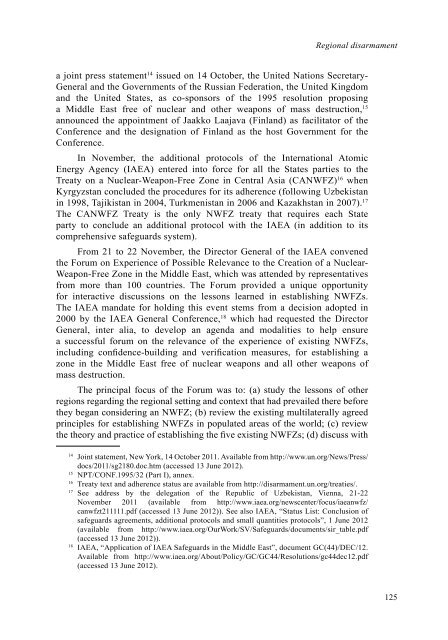DYB2011-Part-II-web
DYB2011-Part-II-web
DYB2011-Part-II-web
Create successful ePaper yourself
Turn your PDF publications into a flip-book with our unique Google optimized e-Paper software.
Regional disarmament<br />
a joint press statement14 issued on 14 October, the United Nations Secretary-<br />
General and the Governments of the Russian Federation, the United Kingdom<br />
and the United States, as co-sponsors of the 1995 resolution proposing<br />
a Middle East free of nuclear and other weapons of mass destruction, 15<br />
announced the appointment of Jaakko Laajava (Finland) as facilitator of the<br />
Conference and the designation of Finland as the host Government for the<br />
Conference.<br />
In November, the additional protocols of the International Atomic<br />
Energy Agency (IAEA) entered into force for all the States parties to the<br />
Treaty on a Nuclear-Weapon-Free Zone in Central Asia (CANWFZ) 16 when<br />
Kyrgyzstan concluded the procedures for its adherence (following Uzbekistan<br />
in 1998, Tajikistan in 2004, Turkmenistan in 2006 and Kazakhstan in 2007). 17<br />
The CANWFZ Treaty is the only NWFZ treaty that requires each State<br />
party to conclude an additional protocol with the IAEA (in addition to its<br />
comprehensive safeguards system).<br />
From 21 to 22 November, the Director General of the IAEA convened<br />
the Forum on Experience of Possible Relevance to the Creation of a Nuclear-<br />
Weapon-Free Zone in the Middle East, which was attended by representatives<br />
from more than 100 countries. The Forum provided a unique opportunity<br />
for interactive discussions on the lessons learned in establishing NWFZs.<br />
The IAEA mandate for holding this event stems from a decision adopted in<br />
2000 by the IAEA General Conference, 18 which had requested the Director<br />
General, inter alia, to develop an agenda and modalities to help ensure<br />
a successful forum on the relevance of the experience of existing NWFZs,<br />
including confidence-building and verification measures, for establishing a<br />
zone in the Middle East free of nuclear weapons and all other weapons of<br />
mass destruction.<br />
The principal focus of the Forum was to: (a) study the lessons of other<br />
regions regarding the regional setting and context that had prevailed there before<br />
they began considering an NWFZ; (b) review the existing multilaterally agreed<br />
principles for establishing NWFZs in populated areas of the world; (c) review<br />
the theory and practice of establishing the five existing NWFZs; (d) discuss with<br />
14 Joint statement, New York, 14 October 2011. Available from http://www.un.org/News/Press/<br />
docs/2011/sg2180.doc.htm (accessed 13 June 2012).<br />
15 NPT/CONF.1995/32 (<strong>Part</strong> I), annex.<br />
16 Treaty text and adherence status are available from http://disarmament.un.org/treaties/.<br />
17 See address by the delegation of the Republic of Uzbekistan, Vienna, 21-22<br />
November 2011 (available from http://www.iaea.org/newscenter/focus/iaeanwfz/<br />
canwfzt211111.pdf (accessed 13 June 2012)). See also IAEA, “Status List: Conclusion of<br />
safeguards agreements, additional protocols and small quantities protocols”, 1 June 2012<br />
(available from http://www.iaea.org/OurWork/SV/Safeguards/documents/sir_table.pdf<br />
(accessed 13 June 2012)).<br />
18 IAEA, “Application of IAEA Safeguards in the Middle East”, document GC(44)/DEC/12.<br />
Available from http://www.iaea.org/About/Policy/GC/GC44/Resolutions/gc44dec12.pdf<br />
(accessed 13 June 2012).<br />
125


